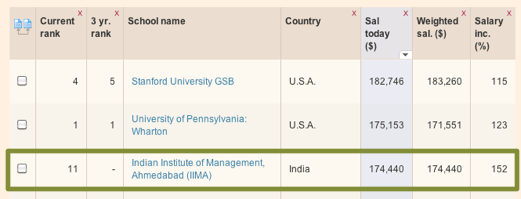The Financial Times has its Global MBA rankings for 2011 out. IIM Ahmedabad is ranked 11th. It was not ranked in previous years. So this is completely out of the blue.
The Economist recently also published their MBA rankings. IIM Ahmedabad was ranked 85th – the only Indian MBA program to be on the list. Which is better than not being on the list, but only just.
So the FT ranking is quite a shot in the arm. I have never had any doubt that my fellow alumni can stand toe to toe with the best. The faculty and research, I know, could improve. But the students are the best anywhere. Yes, they are picky and high maintenance and tend to not fit into every organization. But, at least in part, that is because they are just smarter than the people around them.
OK enough self-serving praise. If IIM A is so hot, how come it didn’t even get a rank till last year?
You have to apply to be ranked, and I don’t know if the institute applied or not. But even so, there are a few things it has ranked high on, which may depend on changes to methodology, and that may have pushed it higher in the rankings.
Take a look at the FT page I have linked to above. It allows some pretty neat analysis on-the-fly.
IIM A has ranked high on Salary Today (3rd) and Weighted Salary (2nd). Since these were computed using PPP (Purchasing Power Parity) it has ranked quite high. It also ranked high on Increase in Salary, before and after the MBA (3rd). Also on Careers and Employment.
Not surprisingly, it ranked low (92nd) on Research and International Faculty (last). It also ranked low on Women in Faculty (12%).
Now, how all this was factored into the final rankings is not something I went into. I expect, Salaries must have had a pretty high weighting in the overall rank computation. Using PPP there, helps a lot, and I would argue is absolutely the right thing to do.
Now if only the institute were freed from the clutches of the government it could do something to attract world-class faculty and focus a lot more on research. Like many things in India (the economy, for instance) IIM Ahmedabad shines, in spite of, not because of its ownership by the Government of India.
[Update: As many readers have informed me, the FT ranking is for the PGP X program which is a 12 month full time MBA that accepts students with considerable work experience (avg 10 years), unlike the PGP program which is a 2 year MBA but accepts many (most?) students straight after college (as I did). The PGP program does not qualify, because of the low work ex requirement, for the FT rankings. The PGP X program, which is new, was ranked for the first time.]

Hi Basab, To clarify, IIMA has applied for this ranking. It has been doing so since 2009, when the 3rd batch of PGPX graduated. FT ranking recognises MBA programmes carrying students with substantial experience. PGPX attracts Executives with average experience of 10 years. This, therefore, qualified the Institute to feature in the rankings. FT needed 4 batches of PGPX to be working (the analysis includes progression of alumni over 3 years). So, it is out of the blue in a sense that the well deserved recognition for the Institute was long awaited. But the efforts were in full swing since PGPX was started. Best regards.
LikeLike
Interesting…thanks for the clarification.
LikeLike
Basab, I would like to point your readers to further references to news on this achievement, via http://goo.gl/16EDC
Best regards.
LikeLike
We rubbish the rankings if it doesnt suit us and grab it if its in our favour. The reality of B-School salary in India should be taken with pinch of salt.
LikeLike
I am not sure if the science behind these rankings is solid enough to be given a lot of importance.
LikeLike
StatSpotting – Do you want to elaborate more? 2 Indian B-schools in a Global ranking is a big deal and my sense is that “Science” behind these rankings is similarly applicable for all the B-schools. Is that not correct? If your argument is the salary numbers are skewed, ask a few MBA candidates on what is their real motive to go to a B-school. If your argument is that PPP-adjusted numbers provide an unreal picture, think again. You may be challenging the “whole PPP-adjusted size of GDP/ economy” concept.
Thanks.
LikeLike